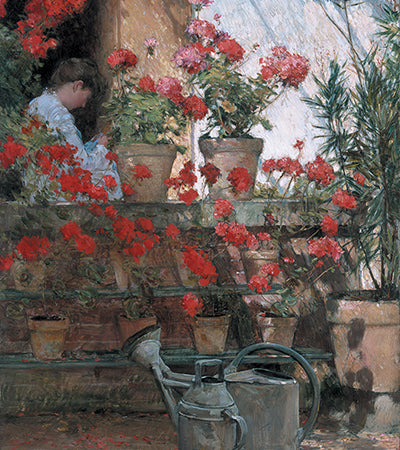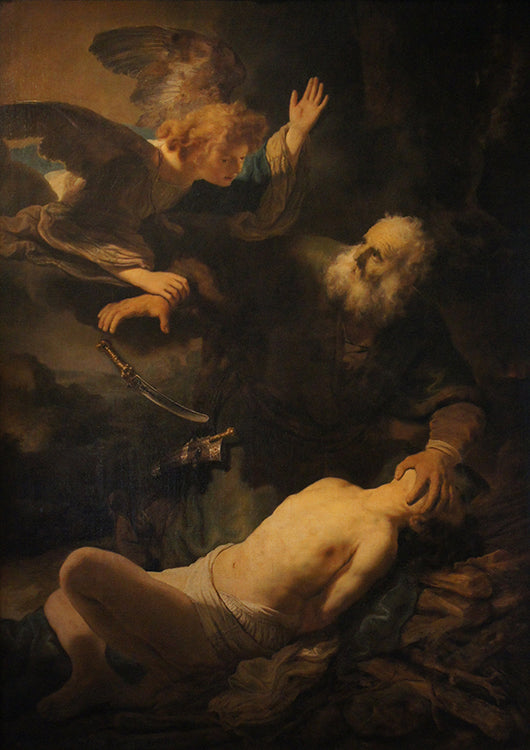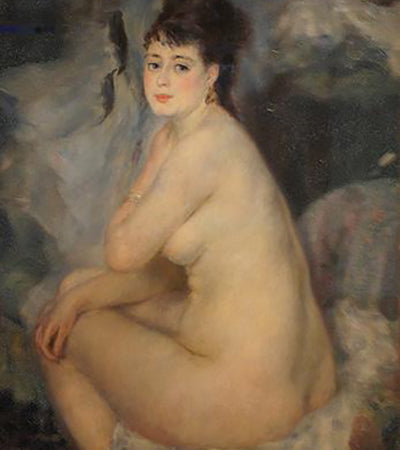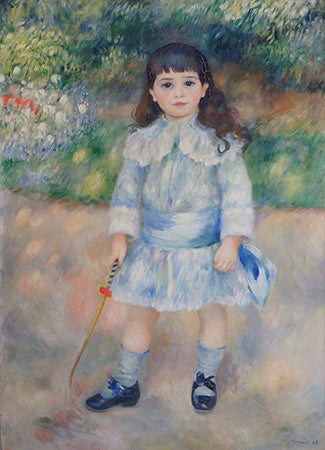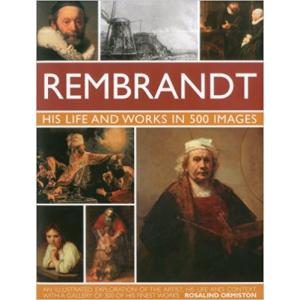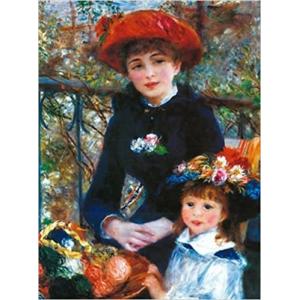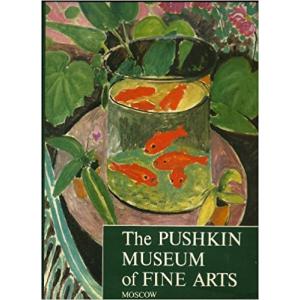The Hyde Collection
by Serena Kovalosky

Hyde House, The Hyde Collection, Glens Falls, New York
The Hyde Collection in Glens Falls, New York is among the exceptional small art museums of the Northeast housing distinguished collections of European and American art. Museum founders Louis Fiske Hyde and his wife, Charlotte Pruyn Hyde were passionate collectors, acquiring the majority of their art, furniture and textiles during a fifty-year period of avid and highly informed collecting.

Photographer Unknown, “Mrs. And Mrs. Hyde,” ca. 1930, gelatin silver print, 3 x 5 in. The Hyde Collection Glens Falls, New York, Hyde Collection Archives, PH183.1
Born in 1867 in Glens Falls, New York, Charlotte Pruyn met her future husband, Harvard-educated lawyer Louis Fiske Hyde, in Boston, Massachusetts as they pursued their education. They married in 1901 and settled near Boston where they were exposed to the city’s thriving artistic and intellectual community. They were particularly impressed by the magnificent home and art collection of Isabella Stewart Gardner which opened to the public in 1903, providing the inspiration for their own house and future museum in Glens Falls which they completed in 1912. Both properties were inspired by Italian architecture encountered during the couples’ travels: Gardner’s courtyard was inspired by the Venetian Palazzo Barbaro while the Hydes’ reflected the Italian country villas of the 1500s. Coincidentally, both Gardner and Charlotte Hyde continued to be the driving force behind their collections and museums following the deaths of their husbands, building their respective museums’ legacy for the education and enjoyment of the public.
The Golden Age of Private Art Collectors
The Hydes’ passion for collecting art was shaped by world travel. They frequently went overseas, boarding steamships and heading for Europe where they visited museums and purchased antique furnishings and works of art. But it was in New York City where they acquired the majority of the artworks that entered their collection. Although the Hydes consulted several art experts, it was William Valentiner, then-director of the Detroit Institute of Art, who became their most trusted advisor.
Their focus reflected that of their contemporaries, acquiring old master paintings and drawings by such artists as El Greco, Rembrandt and Peter Paul Rubens. They had especially wanted a Rembrandt. At the time, it seemed like every important American collector owned at least one Rembrandt painting, and to acquire one would position them as serious collectors.
The search for the perfect painting by the Dutch master, Rembrandt van Rijn (1606-1669), however, was truly a quest for the couple. Charlotte had an opportunity to purchase Rembrandt’s King David while in New York, but the deal fell through. “Buying pictures is a heartrending business,” wrote Louis Hyde. “It almost seems as if we have more heartburnings over lost opportunities than anything else.”
They did, however, get another chance. In 1933 the Hydes were in Berlin with Valentiner to view a Rembrandt painting in a warehouse. Christ with Arms Folded (ca. 1657-1661) once belonged to Russian Count Alexander Orloff Davidoff, which was likely confiscated in 1918 by Vladimir Lenin’s Decree on Land, which declared that the landed estates of the aristocracy and the Orthodox Church should be nationalized and redistributed to peasants by local governments. A decade later, it was vandalized while being stolen from Moscow's Pushkin State Museum of Fine Art. The thieves cut the portrait of Christ from its frame, leaving the rest of the canvas slashed. In 1931, Christ with Arms Folded resurfaced, was returned to the museum, repaired, and put up for sale. The final purchase took the Hydes nearly one year to acquire but the painting finally became part of their collection. Louis Hyde died in 1934, only a year after hanging the Rembrandt in their home.
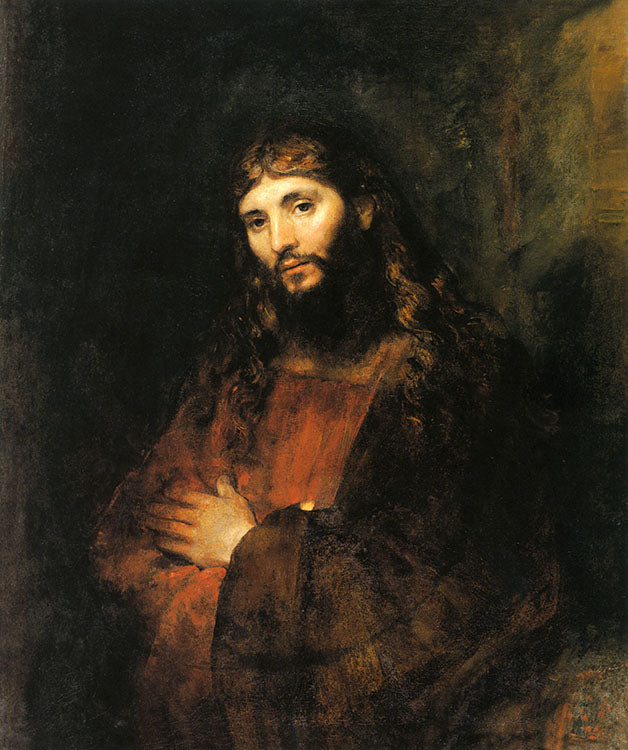
Rembrandt van Rijn, “Christ with Arms Folded,” ca. 1657-1661, oil on canvas, 43 x 35 1/2 in. The Hyde Collection, Glens Falls, New York, The Hyde Collection Trust, 1971.37. Photograph: mclaughlinphoto.com
In the painting, Rembrandt challenges Christian art by using a model to depict the face of Christ rather than the more sacred sources used by artists of the era such as the Veil of Veronica and the Letter of Lentulus. Christ with Arms Folded portrays what curator Lloyd DeWitt called, “...a truly human Jesus.” [5]
American Artists
The Hydes also assembled a significant group of works by important American artists including Thomas Eakins, Childe Hassam, Winslow Homer, Elihu Vedder, and James McNeill Whistler.

Childe Hassam, “Geraniums,” 1888-89, oil on canvas, 18 1/4 x 12 15/16 in. The Hyde Collection, Glens Falls, New York, Bequest of Charlotte Pruyn Hyde, 1971.22. Photograph: mclaughlinphoto.com
The painting, Geraniums, by Childe Hassam (1859-1935) is among the earliest purchases made by Charlotte and Louis Hyde in 1921. It was painted outside of Paris in a country house where the artist and his wife were staying in the summer of 1888. The woman who appears bent over her sewing work is thought to be the artist’s wife. In the painting, Hassam combines the bright light and broken brushwork of impressionism with a touch of descriptive realism. Art historian Ulrich Hiesinger once said of his work, “The picture is exceptional for the delicate care used in rendering the female profile, yet the figure is a secondary though brilliant element in a floral still life of blossoms... Hassam displays a wonderful range of light effects alternating from full sun to shadow, reflecting differently on the various surfaces ... and, not least, with shocking radiance on the red blossoms which seem to burst like scarlet fireworks across the surface of the painting.”
Modern Masters
After the death of her husband in 1934, Charlotte Hyde continued to acquire new works of art and further developed plans to share it with the community. William Valentiner encouraged her to hire a young Harvard graduate by the name of Joseph Jeffers (Jerry) Dodge. Together, they worked to transform her private collection into a public museum. It was also during that time she decided to broaden the scope of the collection, acquiring additional works by such modern masters as Paul Cézanne, Edgar Degas, Pablo Picasso, Pierre-Auguste Renoir, and Georges Seurat. Approximately two-thirds of the core collection reflects her personal decisions and tastes.
The Legacy Continues
Charlotte Pruyn Hyde died in 1963 and a few months later The Hyde Collection opened permanently as a public museum. Since that time, the collection has continued to grow rapidly with works by late nineteenth- and twentieth-century American and European artists.
 Albert Bierstadt (American, b. Germany, 1830-1902) “Yosemite Valley,” ca. 1865, oil on canvas, 21 3/4 x 30 in., The Hyde Collection, Glens Falls, New York, 1976.1. Photograph: mclaughlinphoto.com
Albert Bierstadt (American, b. Germany, 1830-1902) “Yosemite Valley,” ca. 1865, oil on canvas, 21 3/4 x 30 in., The Hyde Collection, Glens Falls, New York, 1976.1. Photograph: mclaughlinphoto.com
Albert Bierstadt (1830-1902) was a German-American painter and among the first artists to travel the American West and attempt to capture its spectacular landscape in paint. He discovered Yosemite Valley on his second western trip and it so caught his imagination that he painted it in various seasons and times of day.
According to art historian Peter H. Hassrick, Bierstadt’s paintings were emotionally healing for Americans embroiled in and recovering from the Civil War. “There was a need to say, ‘Hey, this thing we call the United States of America has something special”… - and that was its landscape….I think these paintings...were a way of helping salve the conscience of a nation that had been profoundly split apart.”[6]
Jerry Cartwright, currently a docent at The Hyde Collection, discusses the Hyde’s Bierstadt painting: “‘Yosemite Valley’(ca. 1865) contains many of Bierstadt’s favorite compositional formulas: the broad, horizontal expanse of earth in the foreground, the deer at the edge of the river providing scale and the fallen tree trunk to the left of the deer that points to the picture plane to emphasize depth. Rugged mountains reach dramatically into the sky,...accented by the strong verticality of the trees before them... One other compositional formula distinguishes Bierstadt from his contemporaries – he typically encloses the space of the painting as he does here with the flanking cliffs and the mountains dimly visible through the haze in the background. The eye is stopped by these encroaching forms from making an easy connection between Earth and sky, between the physical and the spiritual. Bierstadt was not interested in creating a transcendental experience which was so important to some of his contemporaries. Rather, he asks merely that we marvel at the wonders of nature.”
In 2016, The Hyde gained an additional 160 works through a gift from the Feibes and Schmitt Collection, positioning the museum as a regional hub for post-war art.

Grace Hartigan, “White,” 1951, oil on canvas, 39 x 45 in., The Hyde Collection, Glens Falls, New York, The Feibes & Schmitt Collection, 2015.1.19 © of the Grace Hartigan Estate
Today, The Hyde Collection comprises works that span almost six thousand years of art history from antiquity to the present. As stated by Charlotte Hyde in her 1952 Trust Agreement, the founding mission is “to maintain a Museum for the exhibition of the permanent collection and to promote and cultivate the improvement of the fine arts, for the education and benefit of the residents of Glens Falls and vicinity and the general public.”
Collection Website
www.hydecollection.org
Sources
1. The Hyde Collection – www.hydecollection.org/
2. www.gardnermuseum.org
3. www.northcountrypublicradio.org/news/story/32610/20160921/how-the-journey-of-a-4. Rembrandt-masterpiece-ended-here-in-the-north-country
4. www.philamuseum.org/exhibitions/409.html?page=1
5. www.nj.com/gloucester-county/towns/2011/08/rembrandts_paintings_of_a_real.html
6. www.historynet.com/albert-bierstadt.htm
About the Author
Serena Kovalosky is a sculptor, cultural project developer and art film producer. She is the founder of Artful Vagabond Productions, exploring the connection between art, culture and life through film, exhibitions and writing.
Artful Vagabond Productions – www.artfulvagabond.com
Serena Kovalosky artwork – musings-on-art.org/painter/serena-kovalosky


